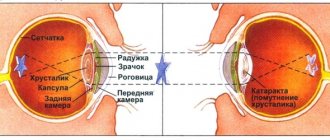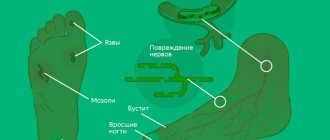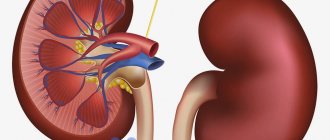..
Diseases of the genitourinary system | Kidneys
With nephropathy (from two Greek words “kidney” and “suffering, illness”), kidney dysfunction occurs in several stages:
- Changes in the composition of the blood passing through the kidneys daily in an amount of about two thousand liters. The causes of changes are numerous - from the effects of toxic substances to systemic pathologies.
- Organic and functional changes in the working apparatus of the kidneys.
- Impaired kidney function (cleansing the blood, excreting urine, synthesizing active substances, maintaining a constant internal environment of the body), affecting the functioning of the body as a whole.
- If the destructive effect of the causative factor persists and kidney damage worsens, renal failure develops, which is an immediate threat to the life of the body.
Diabetic nephropathy
Leader among nephropathies (more than 30%). The scenario of renal disorders includes sclerosis (replacement of working tissue with connective tissue) of the renal tissue and vascular apparatus; decreased tone of the urinary tract and its infection, etc. All this sooner or later leads to a decrease in kidney function and aggravation of systemic disorders in the body (intoxication, loss of protein in the urine, high blood pressure, etc.).
Dysmetabolic nephropathy
Often found in children.
The cause of renal pathology is disturbances of mineral metabolism (calcium, phosphates, uric and oxalic acid; mixed types). They are:
- primary (congenital deficiency of specific enzymes);
- secondary - consequences of excess and/or insufficient intake of substances; disturbances in their metabolism due to a wide range of ailments (urinary system infections, blood diseases and gastrointestinal tract - anemia, myeloma, pancreatitis, Crohn's disease, biliary dyskinesia, parasitic lesions, etc.) and side effects of medications (diuretics, cytostatics, derivatives salicylic acid).
The result of metabolic disorders is an increase in the concentration of the corresponding salts in the urine (sedimentation) with subsequent damage to the working tissue of the kidneys, the possibility of stone formation and the addition of infections.
Gouty nephropathy
It is essentially a type of dismetabolic nephropathy (urate type). The name comes from a pathology leading to kidney damage - gout. It is characterized by a violation of purine metabolism and a long-term increase in the content of uric acid in the blood and urine - the main factor damaging the renal tissue (uric acid salts are deposited in the kidneys, causing stagnation and inflammation, leading to tissue destruction, stone formation and dysfunction).
It is not found in all patients suffering from gout (in about half of the cases). The likelihood of its occurrence increases: alcohol, overeating meat and legumes, obesity, insulin resistance (reduced tissue sensitivity to insulin), prolonged heavy physical activity and drug therapy (diuretics, salicylates).
Arterial hypertension
The hemodynamic theory in the development of diabetic nephropathy is determined by arterial hypertension - a secondary hypertensive condition that develops with pathology of the organs that regulate blood pressure. Arterial hypertension is characterized by resistance to antihypertensive therapy and the development of striking changes in target organs.
Long-term arterial hypertension leads to changes, first from hyperfiltration with accelerated formation of primary urine and the manifestation of proteins, then the tissue of the renal glomerulus is replaced by connective tissue with complete occlusion of the glomeruli. This development leads to chronic renal failure.
Genetic causes
On the genetic side, people with diabetic nephropathy have genetically determined predisposing causes, which recur with metabolic and hemodynamic failures.
Among the causes of diabetic nephropathy are:
- arterial hypertension;
- prolonged hyperglycemia;
- urinary tract infection;
- obesity;
- smoking;
- use of nephrotoxic drugs.
4.What if diabetic nephropathy progresses?
As diabetic nephropathy progresses, blood pressure usually increases, meaning more medications are needed to control it.
Your doctor may recommend one or a combination of the following medications:
- A combination of angiotensin-converting enzyme and angiotensin receptor blockers. The combination of these drugs can have a greater effect in lowering blood pressure than taking them individually.
- Calcium channel blockers lower blood pressure and help blood flow better through the vessels.
- Diuretics will help lower blood pressure by removing sodium and water from the body;
- Beta blockers lower blood pressure by slowing the heartbeat and reducing the amount of blood that will be pumped with each heartbeat.
If you have diabetic nephropathy, it is important to avoid medications that can harm your kidneys (especially nonsteroidal anti-inflammatory drugs). And even if you are undergoing treatment, it is important to control your blood sugar levels and lead a healthy lifestyle, the rules of which we discussed above.
Symptoms of diabetic nephropathy
Diabetic nephropathy is a long-term progressive disease, its clinical indicators are characterized and manifested depending on the stage of changes in the pathology.
Diabetic nephropathy is divided into three stages:
- stage of microalbuminuria;
- proteinuria;
- end-stage chronic renal failure.
Over a sufficiently long period of time, diabetic nephropathy develops without any symptoms. At the beginning it is expressed by increased growth in the size of the glomeruli of the kidneys and an increase in renal blood flow and glomerular filtration rate. After some time has passed after the formation of diabetes mellitus, a structural replacement of the glomerular apparatus of the kidneys appears.
Causes of nephropathy
Diabetic nephropathy is a specific lesion of the tubular and glomerular apparatus of the kidneys (filtering elements) and the vessels that feed them. This is perhaps the most dangerous diabetic complication, which is more common in type 1 diabetes and has several stages of development.
Not every patient with diabetes develops nephropathy, and taking this fact into account, experts put forward the following theories about the mechanisms of development of this complication:
- genetic predisposition,
- hemodynamic disturbances in the kidneys,
- metabolic disorders.
As practice shows, in most cases of diabetic nephropathy, a combination of all three causes is observed. The main factors provoking the development of nephropathy are:
- persistent increase in blood sugar,
- increased levels of triglycerides and cholesterol in the blood,
- arterial hypertension,
- anemia,
- smoking.
Diabetes can have a destructive effect on the kidneys for many years, without causing any negative feelings. It is very important to detect the development of diabetic nephropathy as early as possible, even at the asymptomatic stage, because if clinical signs of the disease begin to manifest themselves, this already indicates the presence of renal failure, which is much more difficult to treat.
Second stage
The clinical picture of diabetic nephropathy becomes pronounced after ten years in the first type of diabetes mellitus and manifests itself in the form of persistent proteinuria, which indicates the irreversibility of the damage. Nephrotic syndrome also develops - massive proteinuria, protein-lipid metabolism is disrupted and edema appears. With nephrotic syndrome, hypoalbuminemia, dysproteinemia, edema of various localizations, degenerative changes in the skin and mucous membranes occur. Creatinine and urea in the blood are at normal levels or slightly elevated.
Diabetes
Diabetic nephropathy is treated with medications that lower blood pressure and protect the kidneys. These drugs can reverse the progression of kidney damage and should be started as soon as any amount of protein is detected in the urine (microalbuminuria). Using medications in this group before the onset of nephropathy can also prevent its development in people with normal blood pressure.
If you have high blood pressure, you may need to take two or more medications to lower your blood pressure without damaging your kidneys. Medications may be added over time as needed. The American Diabetes Association recommends a blood pressure goal of less than 130/80 millimeters of mercury (mmHg). The level recommended by other organizations may vary. Talk to your doctor about your target blood pressure level. For more information about medications that lower blood pressure, see the section on High Blood Pressure (Hypertension).
If you are taking other medications, avoid those that may damage your kidneys, especially nonsteroidal anti-inflammatory drugs (NSAIDs).
It is also necessary to ensure that your blood sugar levels are as close to normal as possible. This prevents damage to the small blood vessels in the kidneys.
Limiting the amount of salt you eat can help prevent your high blood pressure from getting worse. You may also want to limit the amount of protein in your diet. Most doctors recommend that the amount of protein in your diet be no more than 10% of your daily calories. Consult a nutritionist if you need help creating a balanced diet for yourself.
People with diabetes are 2 to 4 times more likely to die from heart and blood vessel disease. Taking low-dose aspirin and following a low-fat diet may help prevent heart attack, stroke, and diseases of other large blood vessels (macrovascular disease).
Initial treatment
Medicines that are used to treat diabetic nephropathy are also used to control blood pressure. If you have small amounts of protein in your urine, these medications may reverse the progression of kidney damage. Medications that may be used for initial treatment of diabetic nephropathy may include:
- Angiotensin-converting enzyme (ACE) inhibitors
such as captopril, lisinopril, ramipril and enalapril. They showed protection for kidney function in people with type 1 diabetes, even those without high blood pressure. ACE inhibitors may reduce urinary protein loss. They may also reduce your risk of developing heart and blood vessel disease (cardiovascular disease). One study found that ramipril reduced the risk of developing cardiovascular disease in people with diabetes (both type 1 and 2) by 25-30%. - Angiotensin II receptor blockers (ARBs)
, such as candesartan, irbesaratan, losartan and telmisartan. You may be prescribed ACE inhibitors and ARAs. A combination of these drugs may provide more protection for your kidneys than either drug alone.
If you have high blood pressure, you may need to take two or more medications to lower your blood pressure without damaging your kidneys. Medications may be added over time as needed. The American Diabetes Association recommends a blood pressure goal of less than 130/80 millimeters of mercury (mmHg).
If you are taking other medications, avoid those that may damage your kidneys, especially nonsteroidal anti-inflammatory drugs (NSAIDs).
You also need to ensure that your blood sugar levels are as close to normal as possible. This prevents damage to the small blood vessels in the kidneys. The American Diabetes Association recommends keeping your blood sugar at:
- 70-130 mg/dL (3.8-7.2 mmol/L) on an empty stomach and 110-150 mg/dL (6.1-8.3 mmol/L) at bedtime.
- Less than 180 mg/dL (10 mmol/L) 1-2 hours after meals.
People with diabetes are 2 to 4 times more likely to die from heart and blood vessel disease. Eating a low-fat diet may help prevent heart attack, stroke, and diseases of other large blood vessels (macrovascular disease).
Limiting the amount of salt you eat can help prevent your high blood pressure from getting worse. You may also want to limit the amount of protein in your diet. Most doctors recommend that the amount of protein in your diet be no more than 10% of your daily calories. Consult a nutritionist if you need help creating a balanced diet for yourself.
Maintenance treatment
As diabetic nephropathy progresses, blood pressure increases, which leads to the need to prescribe additional medications to control it. The American Diabetes Association recommends a target blood pressure level of less than 130/80 mmHg because this level can protect your kidneys. The level recommended by other organizations may differ from this. Discuss your personal blood pressure goal with your doctor.
Your doctor may recommend that you take the following medications to lower your blood pressure. You may need to take different combinations of these drugs to better control your blood pressure. By lowering your blood pressure, you can reduce your risk of kidney damage. Such medications are:
- A combination of angiotensin-converting enzyme (ACE) inhibitors and angiotensin II receptor blockers.
A combination of these drugs may provide more protection for your kidneys than either drug alone.
- Calcium channel blockers
lower blood pressure by facilitating the movement of blood through the vessels. Examples of such drugs are diltiazem (Diacordin), verapamil (Isoptin, Lekoptin), amlodipine (Norvasc, Stamlo, Amlo) and nifedipine (Corinfar, Adalat).
- Diuretics.
Drugs such as chlorthalidone, hydrochlorothiazide, or spironolactone help lower blood pressure by removing sodium and water from the body.
- Beta blockers
lower blood pressure by slowing the heart rate and reducing the amount of blood pumped out with each beat. Representatives of this group of drugs are atenolol, carvedilol or metoprolol.
If you are taking other medications, avoid those that may damage your kidneys, especially nonsteroidal anti-inflammatory drugs (NSAIDs).
It is also necessary to ensure that your blood sugar levels are as close to normal as possible. This prevents damage to the small blood vessels in the kidneys. The American Diabetes Association recommends keeping your blood sugar at:
- 70-130 mg/dL (3.8-7.2 mmol/L) on an empty stomach and 110-150 mg/dL (6.1-8.3 mmol/L) at bedtime.
- Less than 180 mg/dL (10 mmol/L) 1-2 hours after meals.
People with diabetes are 2 to 4 times more likely to die from heart and blood vessel disease. Eating a low-fat diet may help prevent heart attack, stroke, and diseases of other large blood vessels (macrovascular disease).
Limiting the amount of salt you eat can help prevent your high blood pressure from getting worse. You may also want to limit the amount of protein in your diet. Most doctors recommend that the amount of protein in your diet be no more than 10% of your daily calories. Consult a nutritionist if you need help creating a balanced diet for yourself.
People with diabetic nephropathy also have an increased risk of illness and death from heart disease, so you should follow your doctor's recommendations to reduce this risk. Strategies include maintaining your cholesterol levels at a normal level, using low-dose aspirin, exercising regularly, and stopping smoking if you have smoked before.
Treatment if the condition worsens
If damage to the blood vessels in the kidneys continues, kidney failure develops over time. When this happens, dialysis treatment (kidney replacement therapy), an artificial method of filtering the kidneys, is necessary for you to survive; or in kidney transplantation.
Next »
Third stage
At the terminal stage of diabetic nephropathy, the filtration and concentration work of the kidneys decreases, this is massive proteinuria, and an increase in creatinine and urea in the blood. Anemia and edema develop. This stage is characterized by a slight decrease in hyperglycemia and glucosuria, and the emergence of a need for exogenous insulin. Nephrotic syndrome begins to progress, and dyspeptic syndrome, uremia and chronic renal failure with signs of poisoning with its own metabolic products also form.
Diagnosis of diabetic nephropathy
It is quite important to diagnose nephropathy as early as possible. To determine and establish a diagnosis, the following is carried out:
- biochemical analysis;
- general blood diagnostics;
- biochemical and general urine analysis;
- Reberg's test (the effectiveness of the filtration of harmful substances from the blood occurring in the renal glomeruli is calculated; for this purpose, the amount of urine that is formed per minute is calculated, and then the creatinine content in the blood plasma and urine is calculated. Next, the glomerular filtration rate is calculated using a special formula, lowering below the norm indicates renal failure);
- Zimnitsky test (a study that evaluates the ability of the kidneys to concentrate urine. The analysis is carried out throughout the day in eight different containers, in each container for three hours. In the resulting portions of urine, its density and quantity are determined. The daily amount of urine is also calculated in relation to the night and daily, the ratio of urine in relation to the liquid drunk).
The main indicators of the development of the initial stage of diabetic nephropathy are microalbuminuria and glomerular filtration rate.
Diabetic nephropathy and its transition to the stage of proteinuria is determined by the presence of protein in a general urine test. Signs of nephrotic syndrome appear. The last stage is not difficult to determine; against the background of massive proteinuria, an increase in the level of creatinine and urea in the blood appears, and swelling of the whole body appears.
In isolated cases, a fine-needle aspiration biopsy of the kidney is performed to determine diabetic nephropathy.
Using diet for treatment
It is worth noting that diet is also an important point in curing diabetic nephropathy. It is necessary to normalize blood glucose levels and slightly reduce protein in food. The presence of excess protein in foods increases the load on the kidneys. The protein norm is eight grams per kilogram of the patient’s weight. It is necessary to review the list of foods consumed and exclude from the diet foods that are rich in protein, for example, cheese and mushrooms, cottage cheese and meat, and legumes.
It will be very convenient to use a diary with calculations in tables that will be offered to you by an endocrinologist or nephrologist; it will help you calculate how much protein and fat you consume per day is normal and will make appropriate adjustments. Also, to lower blood cholesterol levels, it is useful to add olive oil to salads, and flaxseed oil will help to normalize fat metabolism; it can be purchased in some pharmacies and even in the supermarket.
For quite some time now, there has been a lot of evidence about the usefulness of fish oil for kidney disease. Soy also has many benefits, it has a high iron content and a low amount of fat and carbohydrates, and soy protein has a good effect on the metabolism in the body, so for diabetic nephropathy you need to include soy products in your daily diet.
It is very important to monitor your blood pressure. Antihypertensive drugs are prescribed by the doctor for quite a long time, and even with good indicators, small doses are taken in order to lower the internal pressure of the renal glomeruli.
Many patients with diabetes often develop urinary tract infections because high-sugar urine is a breeding ground for many types of microbes. Therefore, it will be useful to include cranberries and lingonberries in the menu; they contain natural antibacterial effects and resist the growth of microbes.
Treatment of nephropathy
The leading role in the prevention and treatment of all types of nephropathies is played by lifestyle: nutrition, drinking and exercise regimen, resistance to stress. Often, perseverance and consistency in following the correct (for a particular person, taking into account the identified metabolic disorders) regimen is enough for a long-term and lasting improvement in the quality of life. Drug therapy is required for people whose bodies are no longer able to independently compensate for the organic and functional changes that have arisen.
Treatment of diabetic nephropathy
Determined by the stage of the violation. In the early stages, it is sufficient to correct carbohydrate and lipid metabolism (using the above-mentioned win-win method). In the later stages, decongestant, hypotensive, and detoxification therapy is required. Up to the use of hemodialysis with a significant decrease in kidney function.
Treatment of dysmetabolic nephropathy
A priority:
- harmonization of nutrition (the goal is to reduce the intake and/or formation of specific substances - oxalates, phosphates, urates, etc.; reduce the load on the kidneys - low-protein diet);
- drinking regimen (the goal is to reduce the concentration of these substances in the urine, plus detoxification).
Taking vitamins, antioxidants, and membrane stabilizers helps strengthen the body's reserve capabilities (including increasing the resistance of its cells to damaging factors and harmonizing metabolism).
Treatment of gouty nephropathy
All of the above is relevant. To reduce the formation of uric acid in the body and/or to dissolve precipitated salts, medications are used (nicotinamide, allopurinol citrate mixtures, preparations based on lithium salts, etc.). Physiotherapeutic methods are an effective addition.
An effective way to correct metabolic disorders is herbal medicine—individual herbal preparations selected by a doctor based on diagnosis. A significant effect in preventing nephropathies and improving the quality of life if they are present is achieved by a combination of a correct lifestyle and traditional methods of treatment (homeopathy, acupuncture, osteopathy, qigong therapy).
Make an appointment
Prevention of diabetic nephropathy
Timely treatment of microalbuminuria makes it possible to reverse the stage of diabetic nephropathy. With protenuria, it is possible to prevent the progression of the disease even before the onset of chronic renal failure. At the terminal stage of nephropathy, treatment is useless and the outcome is fatal.
Diabetic nephropathy and the formation of chronic renal failure require replacement therapy, that is, kidney transplantation.
In a large number of cases, chronic renal failure will account for the majority of deaths in patients with type 1 disease.
To prevent diabetic nephropathy, systematic monitoring of patients by an endocrinologist and a diabetes physician is required. Constant self-monitoring of the glycemic level will not be superfluous. You must also strictly follow all doctor’s recommendations.








